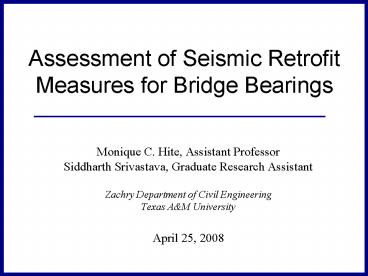Assessment of Seismic Retrofit Measures for Bridge Bearings - PowerPoint PPT Presentation
1 / 22
Title:
Assessment of Seismic Retrofit Measures for Bridge Bearings
Description:
Assessment of Seismic Retrofit Measures for Bridge Bearings ... Steel pedestals may behave like steel bearings when subjected to seismic loads ... – PowerPoint PPT presentation
Number of Views:279
Avg rating:3.0/5.0
Title: Assessment of Seismic Retrofit Measures for Bridge Bearings
1
Assessment of Seismic Retrofit Measures for
Bridge Bearings
- Monique C. Hite, Assistant ProfessorSiddharth
Srivastava, Graduate Research Assistant - Zachry Department of Civil EngineeringTexas AM
University - April 25, 2008
2
Presentation Overview
- Motivation
- Bridge Selection Modeling
- Nonlinear Time History Analyses of Bearings
- Unretrofitted case
- Retrofitted case with cable restrainers
- Conclusions
- Impact Future Research
3
Seismic vulnerability of bearings
1/5 Motivation
Bearings as past unstable supports
Mander et al. (1996)
4
Seismic vulnerability of bearings
1/5 Motivation
Steel pedestals may behave like steel bearings
when subjected to seismic loads
5
Steel Pedestal Performance
1/5 Motivation
strong-axis
initial tangent stiffness
P1-1
secant stiffness
initial tangent stiffness
secant stiffness
P1-2
weak-axis
Hite et al. (2007, 2008)
6
1/5 Motivation
Objectives of Investigation
- To compare the performance of influence of
various types of bearings on the seismic response
of a bridge - To evaluate the effectiveness of using cable
restrainers as a seismic retrofit measures for
steel pedestals and fixed/expansion bearings
compared to FP isolation bearings
7
2/5 Bridge Selection Modeling
Analytical Modeling
GOAL to determine displacement demands
Hite et al. (2007, 2008)
Force-displacement hysteretic relationships
steel pedestals
fixed and expansion bearings
P (lb)
Mander et al. (2006)
friction pendulum isolation bearings
D (inches)
Liberty County Bridge, Georgia
Dicleli (2002)
8
Bridge Model
2/5 Bridge Selection Modeling
- Overview 3D MDOF model developed in SAP2000 six
spans, L245m skew18.5 - Deck modeled as equivalent steel section that
includes a 7" reinforced concrete deck linear
elastic elements used 2 expansion joints modeled
as gap elements - Bearings Hysteretic force-displacement behavior
used to define effective stiffness - Columns frame elements based on confined
concrete model (Mander et al., 1988) - Mass total mass of superstructure and
substructure based on mass of members
bearings
friction pendulum isolation bearings
fixed and expansion bearings
steel pedestals
9
Bridge Model Case 1
2/5 Bridge Selection Modeling
Unretrofitted bridge model with expansion joints
at Bents 2 and 6
10
2/5 Bridge Selection Modeling
Seismic Activity in the United States
The dark areas MMI VIII The light areas MMI
VI-VII
11
Time histories used for model
2/5 Bridge Selection Modeling
0.2g
1.3g
0.35g
0.8g
PGA (in/s2)
PGA (in/s2)
12
Analysis of Results Case 1
3/5 Nonlinear Time History Analyses
13
Analysis of Results Case 1
3/5 Nonlinear Time History Analyses
14
3/5 Nonlinear Time History Analyses
Retrofit Measures
GOAL to limit displacement of these bearings
using cable restrainers
fixed and expansion bearings
Mander et al. (2006)
steel pedestals
Hite et al. (2007, 2008)
Retrofit using cable restrainers, Kr 30 kN/mm
15
Bridge Model Case 2
3/5 Nonlinear Time History Analyses
Retrofitted bridge model with expansion joints at
Bents 2 and 6 using cable restrainers (Kr 30
kN/mm)
16
Analysis of Results Case 2
3/5 Nonlinear Time History Analyses
Retrofit using cable restrainers, Kr 30 kN/mm
17
Deck Displacement Time History CHS 2475
3/5 Nonlinear Time History Analyses
Case 1 P1-2 Tn0.73 s Case 2 P1-2 Tn0.66 s
Max. Absolute Displacement Case 1 P1-2, D 0.78
m (31") Case 2 P1-2, D 0.61 m (24")
18
Bearing Displacement Time History CHS 2475
3/5 Nonlinear Time History Analyses
Case 1 P1-2 Tn0.73 s Case 2 P1-2 Tn0.66 s
Max. Absolute Displacement Case 1 P1-2, D 0.78
m (31") Case 2 P1-2, D 0.61 m (24")
19
Column Displacement Time History CHS 2475
3/5 Nonlinear Time History Analyses
Case 1 P1-2 Tn0.73 s Case 2 P1-2 Tn0.66 s
Max. Absolute Displacement Case 1 P1-2, D 0.54
m (21") Case 2 P1-2, D 0.58 m (22")
20
Conclusions
4/5 Conclusions
- Experimental test data are used to analytically
model the behavior of bridge bearings and assess
their influence of on the seismic response. - Cable restrainers can be used to effectively
limit the displacements of steel pedestals
subjected to synthetic ground motions of
Charleston, SC and other recorded traces. - Depending on the seat width, unseating of these
bearings to large lateral loads may occur. - FP isolation bearings are quite effective in
reducing the displacements demands, thereby
making them viable retrofit measures.
21
Impact Future Research
5/5 Impact Future Research
- Provided results to support the use of steel
pedestals and cable restrainers to limit
displacements demands in regions expecting
moderate-to-high seismicity, thereby showcasing
the wide appeal for their use and ability to also
increase the vertical clearance height of bridges
- Promise lies in more detailed analyses
- Modeling soil-structure interaction
- Conducting parametric studies to determine most
critical (sensitive) aspects such as - Limitations for pedestal height and
configurations - Effect of varying column lengths
- Optimal retrofit measures such bumper blocks,
seat extenders, steel pipe restrainers, etc.
22
Questions?
- Thank you for your kind attention!
23
Experimental Results of Steel Pedestals
24
Experimental Investigation (3/5)
P
25
Performance-Based Design Criteria
from OpenSees analysis































